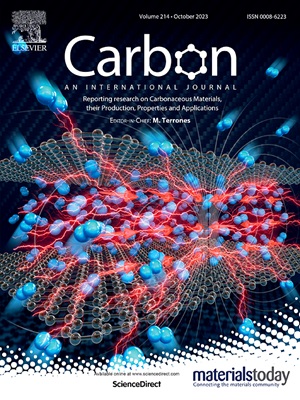Structural details of small non-IPR fullerenes: Experimental and theoretical insights
IF 10.5
2区 材料科学
Q1 CHEMISTRY, PHYSICAL
引用次数: 0
Abstract
The investigation of non-IPR (isolated pentagon rule) fullerenes is limited to theoretical studies since there is simply no or very little sample available that allows investigating these compounds. The discovery of fullerenes in crude oil provided a suitable sample system. The information that might be gathered about these non-IPR fullerenes can be useful for developing synthetic routes and study their properties for potential future applications. Investigations using high-resolution mass spectrometry (HRMS) were conducted to understand the stability of these fullerenes. The experimental results are supported by density-functional-theory (DFT) calculations. The outcome of HRMS and DFT provided results on relative quantity, stability and basic mechanistic fragmentation information. The results showed that non-IPR fullerenes were present in higher abundances than the most stable C60-buckminsterfullerene. The investigation of C30 to C44 indicates C32 and C36 to be the most stable congeners, which is in accordance with the existing theory. The mechanism of fragmentation is, in general, marked by the loss of C2 and a subsequent Stone-Wales-transformation into an energetically more stable isomer. The fragmentation behavior differs with size as the smaller fullerenes disintegrate easier instead of losing C2-units. This study shows that crude oil makes up a very useful sample system for the investigation of non-IPR fullerenes.

求助全文
约1分钟内获得全文
求助全文
来源期刊

Carbon
工程技术-材料科学:综合
CiteScore
20.80
自引率
7.30%
发文量
0
审稿时长
23 days
期刊介绍:
The journal Carbon is an international multidisciplinary forum for communicating scientific advances in the field of carbon materials. It reports new findings related to the formation, structure, properties, behaviors, and technological applications of carbons. Carbons are a broad class of ordered or disordered solid phases composed primarily of elemental carbon, including but not limited to carbon black, carbon fibers and filaments, carbon nanotubes, diamond and diamond-like carbon, fullerenes, glassy carbon, graphite, graphene, graphene-oxide, porous carbons, pyrolytic carbon, and other sp2 and non-sp2 hybridized carbon systems. Carbon is the companion title to the open access journal Carbon Trends. Relevant application areas for carbon materials include biology and medicine, catalysis, electronic, optoelectronic, spintronic, high-frequency, and photonic devices, energy storage and conversion systems, environmental applications and water treatment, smart materials and systems, and structural and thermal applications.
 求助内容:
求助内容: 应助结果提醒方式:
应助结果提醒方式:


